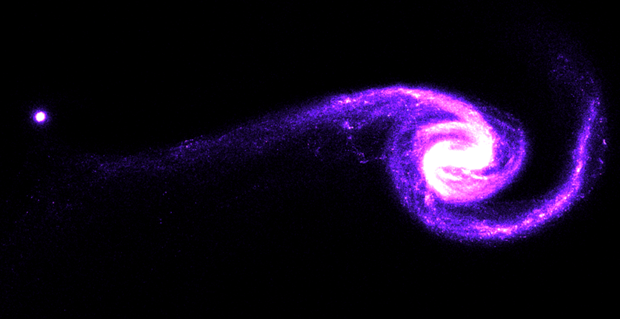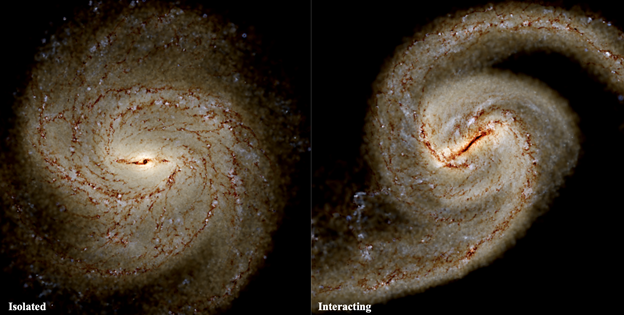Astrophysicists from the Sydney Institute for Astronomy (SIfA) at the University of Sydney are using the computing power of the National Computational Infrastructure (NCI) to create virtual cosmic playgrounds, offering insights into our Galaxy's past, present and future. By constructing a model of a galaxy and allowing a small satellite to pass by, called a minor interaction, researchers from SIfA can get insight into how the tidal forces of this experience can impact what happens in the main galaxy.
Dr. Elizabeth Iles, a postdoctoral fellow at SIfA, employs the resources of NCI to delve into the mysteries of cosmic phenomena found at the heart of 60%-80% of disk galaxies – the enigmatic galactic bars. Most galaxies with shapes like our Milky Way are graced with these bars. Even a minor interaction, often with a passing object such as a dwarf galaxy with around 10% the mass of the main galaxy, can significantly impact the formation of these bars. It has the potential to either slow down, speed up or even trigger their formation, depending on the type of interaction. Two primary outcomes can be considered for the smaller companion and the main galaxy:
- A "fly-by" interaction, where the passing companion swings by the galaxy and then passes away. The closest approach in such cases typically occurs near the galaxy's visible edge, before it is swept off and travels away again in a different direction.
- A "merger" scenario, in which the satellite is gravitationally captured by the galaxy and eventually merges completely with it. Evidence of this process is seen in the Milky Way, where the remnants of objects previously merged with the Galaxy appear as stellar streams with different properties to the disk around them as they assimilate with the Galactic structure.
Tidal interactions are relatively frequent and important for restructuring various components within galaxies. They are an integral part of the complex evolutionary histories forming the galaxies we see today.
To understand the formation and effects of these enigmatic cosmic structures, Dr Elizabeth Iles currently intends to construct model galaxies for a sample of thirty disks, evolved from ten initial conditions which differ based on baryon-dark matter fraction (four galaxies) and the shape of the rotation curve (four galaxies) but which are generally considered to be similar to the Milky Way overall. Many scientists use the Milky Way galaxy as a standard, however, we are also interested in researching other nearby galaxies that are alike to the Milky Way, either in mass, shape, or star forming activity, to identify if the Milky Way is really special or if it is, instead, some kind of universal standard. The group aims to build up a sample of thirty similar galaxies, by incorporating a small interaction into the ten initial models with ten of 5% the mass of the main galaxy and ten of 10% the mass of the main galaxy. The research group at SIfA can then use this sample of galaxies to compare slightly different but similar galaxies with different evolutionary histories to observe any trends within the simulated sample and to compare with real galaxies observed by a range of modern telescope facilities.
Dr Elizabeth Iles relies on the NCI facilities to make these simulations work efficiently. In particular, the computing power of the NCI is needed to handle the sheer volume of simulated particles that make up these galaxy disks. To be able to resolve clear structural features like the bar and spiral arms of the galaxy, a resolution of at least 10 million stellar particles alone is necessary, not including other important components, such as gas and dark matter. This makes these simulations complex and computationally intensive and can take anything between 24 hours (with no tidal interaction) and up to a month to sufficiently evolve a galaxy, even while using the supercomputing power at NCI.
Some of the questions that Dr Elizabeth Iles aims to answer after the sample of galaxies has been evolved using the NCI power are confirmation that the bar formation time-scale varies with the ratio of baryon-total mass and, therefore, a means to explain the early bars found by researchers using the new James Webb Space Telescope (JWST), as well as to estimate the fractions of dark matter in the universe from numbers of barred galaxies. Ideally, they would also like to understand whether the tidal forces impacting the formation of a stellar bar will also, in turn, affect how the bar itself will impact the galaxy it is present in.
As the research unfolds, we might finally learn why bars are so ubiquitous in galaxies, and what impact they have on the universe we see today. This is a journey through the cosmos, driven by curiosity, and enabled by cutting-edge technology at NCI.

